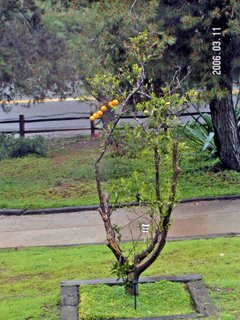 The lanterns are hanging from a bamboo pole, mounted in front of a wooden screen leaning against a south-facing wall. When scattered about my back yard, these cheap, faux Asian lanterns failed to convey the Zen-like quality I was going for. Instead, isolated from each other, individual lanterns imparted a forlorn failed ambience and showcased instead my yard’s intrinsic lack of design coherence.
The lanterns are hanging from a bamboo pole, mounted in front of a wooden screen leaning against a south-facing wall. When scattered about my back yard, these cheap, faux Asian lanterns failed to convey the Zen-like quality I was going for. Instead, isolated from each other, individual lanterns imparted a forlorn failed ambience and showcased instead my yard’s intrinsic lack of design coherence. But, taken together they transcend trash. By grouping the lanterns together, I have raised the individual elements above their humble stations to the level of garden whimsy.
And garden whimsy is something people are writing expensive coffee-table books about. Apparently, you can spend a lot of money at garage sales and flea markets to find old garden implements, buckets, birdhouses. You can plant flowers in your old wheelbarrow. You can paint old chairs in bright colors and plant trailing ivy on their seats. If you don’t have the creative talent to recognize the whimsical potential of such hidden treasures at junk stores, you can go to shops in gentrified parts of old urban downtowns and spend even more money for the same used resale items, displayed with a quirky eye, a bit of old lace and some silk flowers. Why didn’t you think of that?
I have to wonder however, if these attempts to achieve the wa of garden whimsy today, risk sinking to the level of clutter and trash tomorrow. Will today’s attempts to create cottage garden informality and country charm, despite being costly, clever and oh-so-current, end up becoming trite? The lesson to consider here is the way our grandparents would take old tires, cut them in half, paint them white, and stand them end-to-end like upside-down Us to border their driveways. Or stack them and plant strawberries in their centers.
Once upon a time, painting old tires white was the height of garden whimsy, although we hadn’t even invented the concept in those days. Today, it is pre-packaged for the modern whimsical gardener-on-the-go, who is looking for instant harmony, peace and balance befitting their busy contemporary lifestyle. Besides, I too have a wheelbarrow planted with flowers, and I like it just fine.

















































